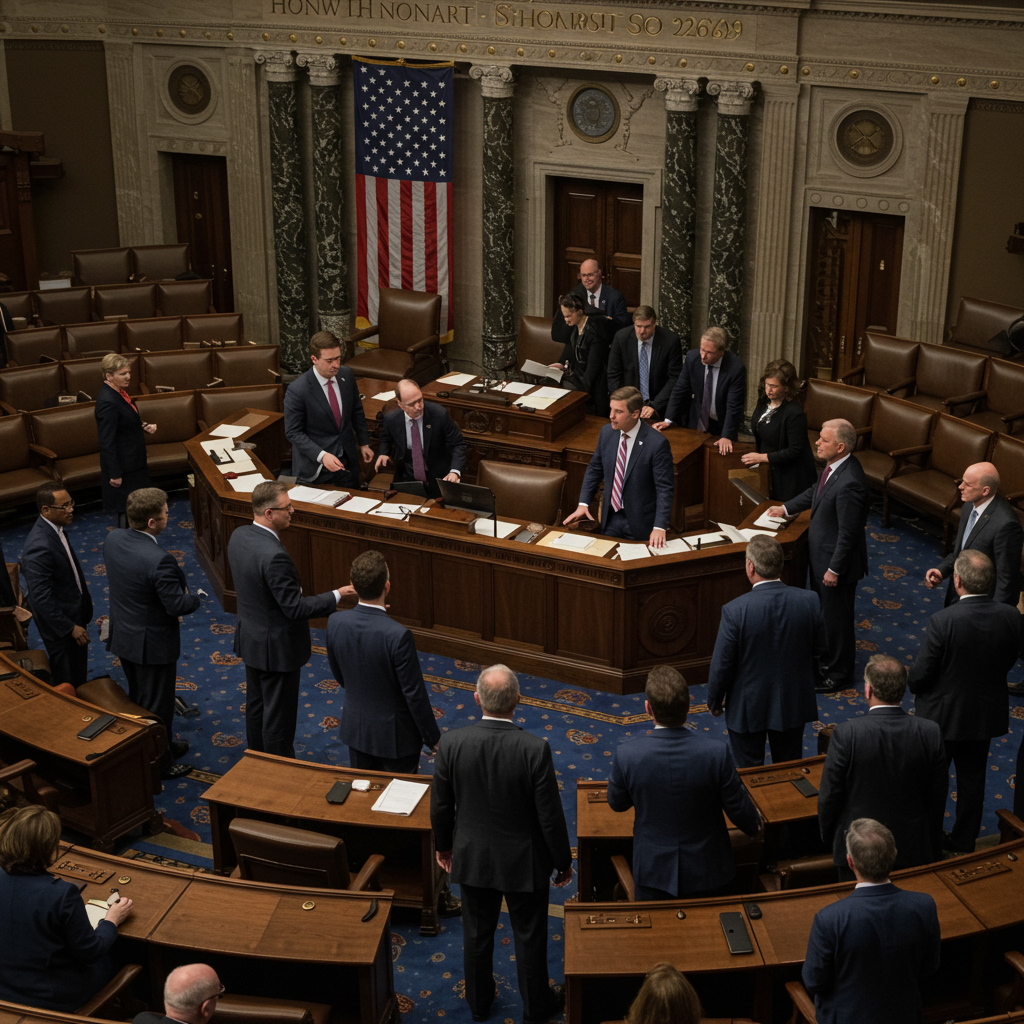The United States government shutdown entered its 15th contentious day on October 15, 2025, with no clear resolution in sight. A critical Senate vote on a House-passed Republican funding bill failed for the ninth time, underscoring a deep partisan deadlock in Washington D.C. This ongoing legislative impasse continues to cast a long shadow over federal operations, impacting thousands of federal workers and military families while escalating political tensions between Democrats and Republicans. As essential services face disruption, leaders on both sides grapple for a path forward amidst threats of widespread layoffs and a looming “health care crisis.”
Legislative Gridlock Intensifies: Senate Rejects Funding Bill Again
On Wednesday, the Senate once again failed to advance a House-passed GOP bill aimed at funding the government until November 21. The procedural vote of 51 to 44 fell significantly short of the 60 votes needed, marking the ninth such rejection since the government shutdown began. Republicans have consistently sought to peel off support from Democrats, but the necessary five additional votes have remained elusive, solidifying the congressional impasse.
Democrats are steadfast in their demands. They insist that any funding agreement must include an extension of health care tax credits, vital components of the Affordable Care Act (ACA). House Minority Leader Hakeem Jeffries explicitly urged House Republicans to return to Washington and negotiate. He stressed the importance of extending ACA tax credits to prevent dramatically increased health care premiums for millions and ensure accessible medical care. Earlier, Senate Minority Leader Chuck Schumer controversially remarked that “every day gets better for us” during the shutdown, later clarifying that he meant more Americans were realizing the severity of the health care crisis and seeing Democrats fight for them.
Republicans, however, argue for a “clean” continuing resolution (CR) to reopen the government first, delaying health care negotiations. House Speaker Mike Johnson reiterated this stance, placing the blame squarely on Democrats for the ongoing funding lapse. Senate Majority Leader John Thune echoed these sentiments, accusing Democrats of being “dug in” and motivated by “pleasing their far-left base” rather than ending the government shutdown.
Looming Financial Crisis for Federal Workers and Military Families
The prolonged government shutdown has severe financial consequences, directly affecting federal employees and military personnel. A temporary fix allowed military members to receive their paychecks on October 15, directed by President Trump. This involved tapping approximately $8 billion in unused research and development funds from the previous fiscal year. Homeland Security Secretary Kristi Noem also confirmed that Coast Guard personnel received their paychecks through similar measures.
However, this relief is temporary. House Speaker Mike Johnson warned that troops risk missing their next paychecks at the end of the month if the shutdown continues. He attributed this risk to “Democrat obstruction,” creating significant anxiety for military families reliant on these earnings.
The situation for broader federal workers is even more precarious. Russell Vought, head of the White House Office of Management and Budget (OMB), has articulated an aggressive strategy, signaling that layoffs (officially termed “Reductions in Force,” or RIFs) of federal workers could exceed 10,000. He noted that over 4,000 notices had already been issued as a “snapshot,” adding, “it’ll get much higher.” Vought explicitly stated, “We’re going to keep those RIFs rolling throughout the shutdown, because we think it’s important to stay on offense for the American taxpayer and the American people.” He framed the shutdown as an “opportunity” to “shutter the bureaucracy,” targeting programs like “Green New Deal programs at the Department of Energy” and “environmental justice at EPA.”
Legal Challenges and Calls for Back Pay Clarity
This aggressive stance by the administration has faced legal pushback. A federal judge in California issued a temporary restraining order, blocking these widespread layoffs, finding the administration’s actions likely “contrary to federal law.” The judge accused the administration of taking advantage of the lapse in government spending to act as if “all bets are off.”
Adding to the pressure, a bipartisan group of lawmakers, including Republican Sen. Lisa Murkowski of Alaska, sent a letter to OMB Director Vought. They urged immediate clarification that federal workers will receive back pay once the shutdown concludes, citing the Government Employee Fair Treatment Act of 2019. Historically, furloughed workers receive retroactive pay, but President Trump had previously threatened to block back pay for some, creating additional uncertainty. The extensive cuts have already impacted critical agencies, with approximately 600 employees at the Centers for Disease Control and Prevention (CDC) receiving permanent layoff notices. Union representatives for Capitol Police have also highlighted that officers are protecting lawmakers without full pay.
Political Blame Game and Strategic Shifts
The political rhetoric surrounding the government shutdown remains sharply divided. Republican leaders, including Senator Thune and Speaker Johnson, consistently accuse Democrats of prioritizing their “far-left base” over ending the crisis. Thune criticized Democrats for perceived indifference to military families, recipients of nutrition assistance, and Americans in flood zones, stating they are “dug in.”
Democrats, led by House Minority Leader Hakeem Jeffries, counter that House Republicans “shut the government down, then they ran out of town.” Jeffries declared Democrats are “here, reporting for duty” and ready to negotiate a bipartisan spending agreement. He emphasized addressing what he termed the “Republican health care crisis.”
In a notable strategic shift, Senate Majority Leader John Thune announced plans to pivot from the repeatedly failed stopgap measures. He intends to attempt advancing individual year-long appropriations bills, starting with the Pentagon funding bill on Thursday, with the possibility of attaching other funding measures. This move represents an alternative “off-ramp” that could put pressure on Democrats who have expressed support for the regular appropriations process. Thune acknowledged that “Shutdowns are not good for anybody, and the sooner we end it the better.”
A glimmer of hope for dialogue emerged as House Speaker Mike Johnson and House Democratic Leader Hakeem Jeffries accepted an invitation to appear together on C-SPAN’s “Ceasefire” program. This rare joint appearance aims to provide a “smart, civil, respectful exchange of ideas.” This follows Johnson’s earlier C-SPAN appearance where a military mother emotionally pleaded for a standalone bill to pay the troops, underscoring the real-world impact of the legislative deadlock. Furthermore, Senator Murkowski highlighted a “lack of trust” between the parties, partly attributed to controversial “pocket rescissions”—a tactic where the OMB unilaterally declines to spend congressionally approved funds.
Broader Implications and Public Sentiment
As the government shutdown continues, the stakes grow higher. House Speaker Johnson has warned it could become “the longest shutdown in U.S. history,” an outcome with potentially severe economic and social repercussions. While the stock market initially showed resilience, recent dips indicate growing investor concern. The nonpartisan Congressional Budget Office also reported a federal budget deficit of $1.8 trillion, underscoring broader fiscal challenges.
Public opinion, as reflected in a Reuters/Ipsos poll, shows widely distributed blame for the shutdown, with over 60% blaming congressional Republicans, President Trump, and congressional Democrats. Trump’s threat to fire federal workers resonated with a majority of Republicans but saw significantly lower support among Democrats. The continued impasse underscores the deep ideological chasm preventing a swift resolution, leaving countless Americans in uncertainty.
Frequently Asked Questions
Why has the Senate failed to fund the government multiple times?
The Senate has repeatedly failed to pass government funding bills primarily due to deep partisan disagreement. For the ninth time, a House-passed GOP bill could not secure the 60 votes needed to advance. Democrats demand an extension of Affordable Care Act (ACA) tax credits as a condition for their votes, arguing it’s essential to prevent a “health care crisis.” Republicans, conversely, insist on a “clean” temporary funding bill first, refusing to negotiate on healthcare at this stage. This ideological divide on both policy priorities and negotiation tactics has led to the persistent legislative deadlock.
How are federal workers and military families being impacted by this shutdown?
The government shutdown significantly impacts federal workers and military families financially. While a temporary fix allowed military personnel to receive their October 15 paychecks, House Speaker Mike Johnson warned they risk missing future payments if the shutdown persists. For other federal workers, the situation is dire, with the White House Office of Management and Budget anticipating over 10,000 permanent layoffs (RIFs). These layoffs have already affected agencies like the CDC. Although a federal judge issued a temporary restraining order blocking some layoffs, the threat of job loss and delayed or lost paychecks creates immense stress and uncertainty for hundreds of thousands of families.
What new strategies are congressional leaders pursuing to end the government shutdown?
Senate Majority Leader John Thune is pursuing a new strategy to break the impasse. Instead of repeatedly voting on stopgap measures, he plans to attempt advancing individual year-long appropriations bills, starting with the Pentagon funding bill, with the possibility of attaching other funding measures. This aims to find common ground on specific government functions. Additionally, House Speaker Mike Johnson and House Democratic Leader Hakeem Jeffries have accepted an invitation to appear together on C-SPAN’s “Ceasefire” program. This rare joint appearance seeks to foster a “smart, civil, respectful exchange of ideas” and potentially open new avenues for negotiation and resolution.
The government shutdown on Day 15 reflects a profound political divide, marked by a record nine failed Senate votes and escalating rhetoric. With military families facing future pay uncertainty and federal workers confronting widespread layoffs, the human cost is mounting. While new strategies like individual appropriations bills and public dialogue initiatives offer glimmers of hope, the fundamental disagreements over healthcare funding and the scope of government continue to block a comprehensive resolution. The path to reopening the government remains as uncertain as the political landscape itself.



